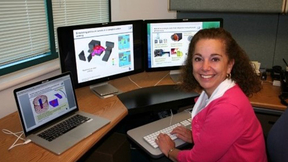Back
Physical and Life Sciences
Go-getter undergrad lands second-author credential for 'hydrogen-getters' research
It’s rare for an undergraduate science student to appear as an author on a scientific journal paper, and when they do, theirs is usually the last name on the list. However, Elizabeth Sangalang, a graduating senior studying biochemistry at California State University East Bay, has landed a second-author credential through the research she completed as a summer intern at…
First experimental evidence for superionic ice
Among the many discoveries on matter at high pressure that garnered him the Nobel Prize in 1946, scientist Percy Bridgman discovered five different crystalline forms of water ice, ushering in more than 100 years of research into how ice behaves under extreme conditions. One of the most intriguing properties of water is that it may become superionic when heated to several…
Researchers characterize membrane behavior
An article authored by a team of Lawrence Livermore National Laboratory (LLNL) scientists has characterized how different cell membranes behave. "Different membranes in different parts of the body have different barrier strengths that are required for drugs to penetrate them to reach the organ," said Tim Carpenter, a computational biophysicist in the Lab’s Biosciences and…
LLNL’s Academic Collaboration Team Focuses on Strategic Partnerships
The High Energy Density (HED) Science Center at LLNL participates in the Laboratory’s Academic Collaboration Team (ACT), established in early 2018, which also includes LLNL’s Inertial Confinement Fusion and Weapon Physics Design programs. The goal of this multidisciplinary team is to advance LLNL’s strategic partnerships with universities, and the HEDS Center contributes…
Scientists discover ideal material for smart windows that convert sunlight to electricity
Imagine a smart window that becomes transparent when it is dark or cool but darkens when the sun is bright, converting that sunlight into electricity. Typical smart windows absorb or reflect sunlight without actually converting the solar energy into a useful form. However, the new photovoltaic windows would convert the sunlight on bright days into energy that provides more…
Lab earns DOE grant for collaboration to improve growth, efficiency of biofuel-producing algae
The Department of Energy has awarded Lawrence Livermore National Laboratory (LLNL) a three-year, $1.5 million grant to improve the growth and efficiency of biofuel-producing algae through the alteration of their microbiomes. The work, which is led at LLNL by Xavier Mayali and Ty Samo in the Physics and Life Sciences Directorate, will be done in collaboration with the San…
Alan Hidy's global travels lead to a CAMS career
The bookcase in Alan Hidy’s office is loaded with carefully labeled bags of rocks -- some the size of a fist, others pulverized into dust. The granite in these bags is destined for isotope ratio measurement at Lawrence Livermore National Laboratory's Center for Accelerator Mass Spectrometry (CAMS). "These are from the Sierras," Hidy said, referring to his ongoing study of…
Looking to the sun to create hydrogen fuel
When Lawrence Livermore scientist Tadashi Ogitsu leased a hydrogen fuel-cell car in 2017, he knew that his daily commute would change forever. There are no greenhouse gases that come out of the tailpipe, just a bit of water vapor. The market for hydrogen cars is growing. According to a recent report by the California Energy Commission and the California Air Resources Board…
Meteorites reveal story of Martian climate
Liquid water is not stable on Mars’ surface because the planet’s atmosphere is too thin and temperatures are too cold. However, at one time Mars hosted a warm and wet surface environment that may have been conducive to life. A significant unanswered question in planetary science is when Mars underwent this dramatic change in climate conditions. New research by Lawrence…
Newly developed tunable, green detergents could be 'made-to-order' for industry
That mascara that your colleague is wearing may contain components from a microorganism. Detergents, also known as surfactants, are used extensively in the cosmetics, oil, food, agriculture, healthcare and pharmaceutical industries. Their sales are projected to reach $42 billion by 2020. The majority of surfactants are petrochemicals, i.e. are synthesized from petroleum…
Workshop Explores National Security Dimensions of HED Science
LLNL’s High Energy Density (HED) Science Center helped organize a two-day workshop regarding national security and HED science, held in January 2018 at the University of California (UC) San Diego. The workshop offered an introductory exploration of the national security dimensions of HED science from technical, policy, and international perspectives. Scientists from…
Project to study climate effects on California water systems from headwaters to groundwater
To address future climate change effects on water resources, scientists at five UC campuses, and Lawrence Livermore and Lawrence Berkeley national laboratories will study California’s water systems, from the headwaters in the Sierra Nevada, through rivers, reservoirs and groundwater in the Central Valley. The "Headwaters to groundwate resources in a changing climate"…
LLNL nanolipoprotein technology licensed
A Lawrence Livermore National Laboratory (LLNL) biomedical technology that can deliver vaccines and drugs inside the human body has been licensed for use in cancer treatments to a Michigan company. The Livermore-developed technology, using nanolipoprotein particles (NLPs), has been licensed to Ann Arbor-based EVOQ Therapeutics for cancer immunotherapy, which deploys the…
'Brain-on-a-chip' tests effects of biological and chemical agents, develop countermeasures
Lawrence Livermore National Laboratory (LLNL) scientists and engineers have developed a "brain-on-a-chip" device aimed at testing and predicting the effects of biological and chemical agents, disease or pharmaceutical drugs on the brain over time without the need for human or animal subjects. The device, part of the Lab’s iCHIP (in-vitro Chip-Based Human Investigational…
LLNL-developed microelectrodes enable automated sorting of neural signals
Thin-film microelectrode arrays produced at Lawrence Livermore National Laboratory (LLNL) have enabled development of an automated system to sort brain activity by individual neurons, a technology that could open the door to recording and analyzing unprecedented amounts of neural signals over time, and, ultimately, provide scientists with new clues about how the brain…
Arctic sea ice loss could dry out California
Arctic sea ice loss of the magnitude expected in the next few decades could impact California’s rainfall and exacerbate future droughts, according to new research led by Lawrence Livermore National Laboratory (LLNL) scientists. The dramatic loss of Arctic sea ice cover observed over the satellite era is expected to continue throughout the 21st century. Over the next few…
New study verifies more paths to survival for endangered winter-run Chinook salmon
The most treacherous journey of any salmon’s life is from its natal river to the ocean when it is still a juvenile, usually when they are only a few months old. For endangered salmon, this early journey is a matter of life and death for the whole population. In a new study from the Metropolitan Water District (MWD), University of California, Davis, the NOAA Fisheries…
A Reversible Reaction Captures Carbon
To combat climate change and other anthropogenic environmental impacts, researchers have identified and analyzed major sources of pollution.
Clay mineral waters Earth's mantle from inside
The first observation of a super-hydrated phase of the clay mineral kaolinite could improve the understanding of processes that lead to volcanism and affect earthquakes. In high-pressure and high-temperature X-ray measurements, Lawrence Livermore National Laboratory scientist Hyunchae Cynn and colleagues from Yonsei University in the Republic of Korea, Deutsches Elektronen…
First forms of life on Earth unveiled in hot spring
Terrestrial geothermal systems are like buried treasure when it comes to finding out the origins of life on Earth. In these underground hot springs, some of the most ancient single-celled bacteria and archaea live the life of extremophiles (organisms that live under extreme environmental conditions such as hot springs or ice caps). By their makeup alone, the microorganisms…

























